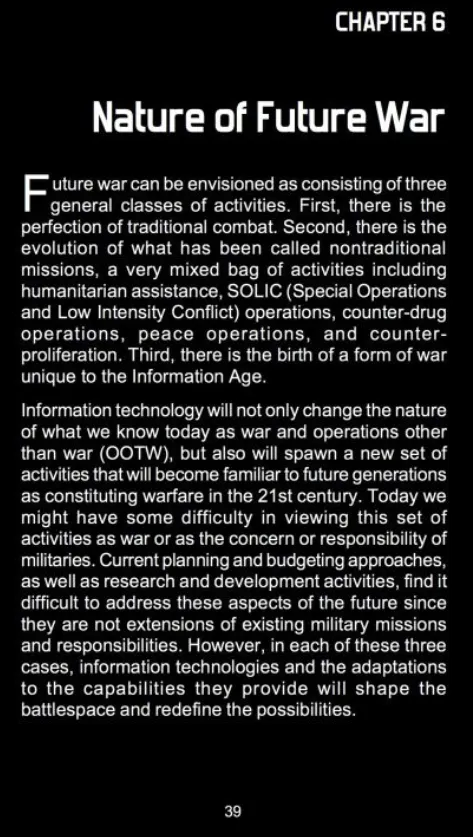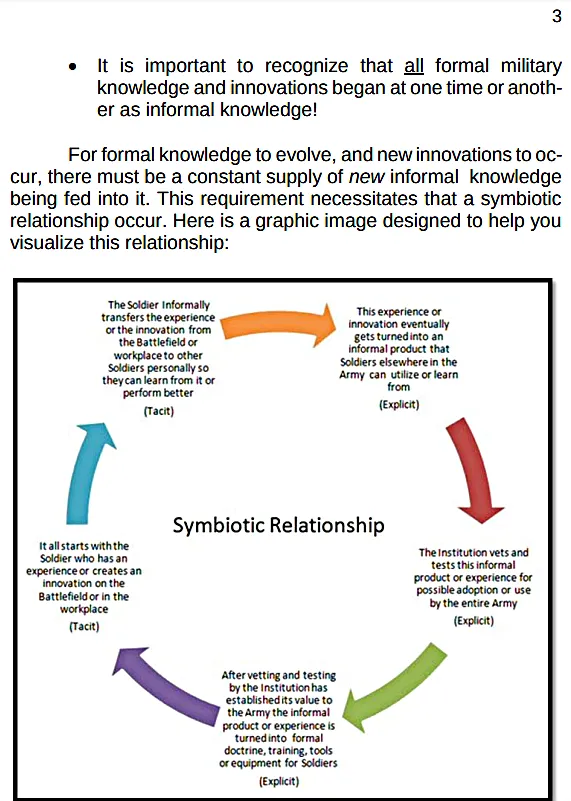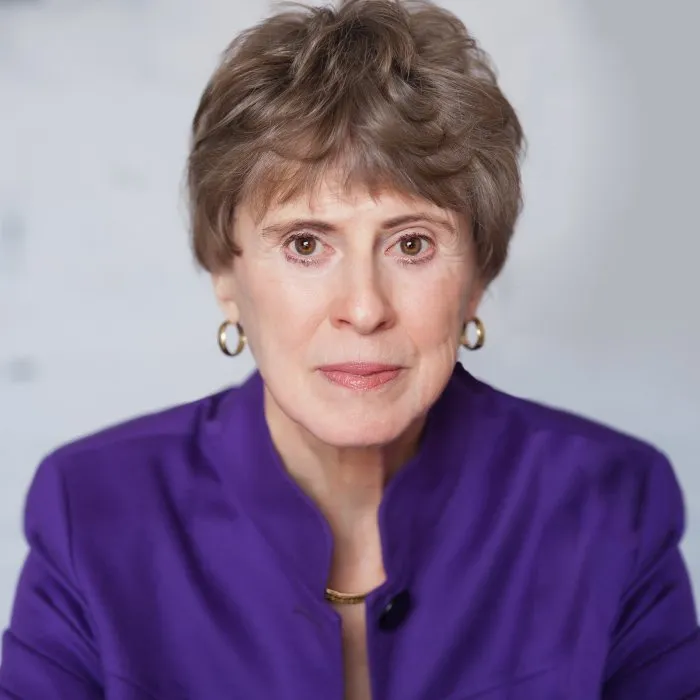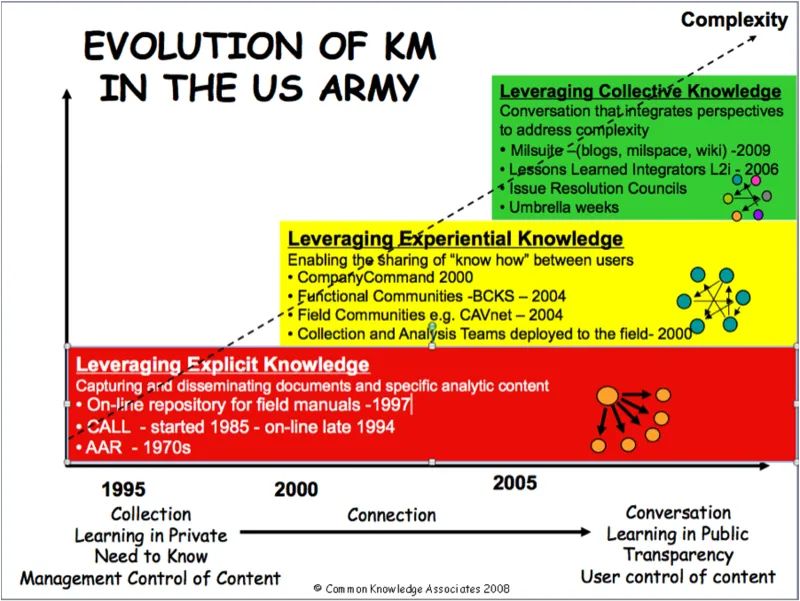by assembling and quoting excerpts collected from US Army published Knowledge Management texts which are over a decade old.
| Nature of Future War | |
|---|---|
| Nature of Future War Future war can be envisioned as consisting of three general classes of activities. First, there is the perfection of traditional combat. Second, there is the evolution of what has been called nontraditional missions, a very mixed bag of activities including humanitarian assistance, SOLIC (Special Operations and Low Intensity Conflict) operations, counter-drug operations, peace operations, and counter-proliferation. Third, there is the birth of a form of war unique to the Information Age. Information technology will not only change the nature of what we know today as war and operations other than war (OOTW), but also will spawn a new set of activities that will become familiar to future generations as constituting warfare in the 21st century. Today we might have some difficulty in viewing this set of activities as war or as the concern or responsibility of militaries. Current planning and budgeting approaches, as well as research and development activities, find it difficult to address these aspects of the future since they are not extensions of existing military missions and responsibilities. However, in each of these three cases, information technologies and the adaptations to the capabilities they provide will shape the battlespace and redefine the possibilities. |  |
Knowledge Transfer for the Military Leader
by R. A. Dalton - 2010 - Acknowledgments
I would like to acknowledge the following who have made this book possible.
To the four officers (Kilner, Burgess, Allen and Schweitzer) who created CompanyCommand and wrote the first military specific book on communities of practice
LTC(R) Richard Kreuscher who became a friend and mentor during my days with the LogNet military community of practice which I facilitated from 2005-2007. He allowed me the freedom to innovate and explore while protecting me from the Army bureaucracy
Mr. Todd Miller at milWiki for his constant “can do” attitude and willingness to take on anything, while making whatever I dreamed up become a reality.
Mr. Peter Morrison, Chief Executive Officer, Bohemia Interactive Simulations Group in Australia for coming up with VBS2, which will change how the military transfers tactical knowledge and experience forever.
LTC Liam Hale of the Australian Army for giving me a singular epiphany moment on structured socialization and how it works.
To the Israeli military for showing me that knowledge transfer doesn't have to be complex to work.

What we are trying to achieve with knowledge transfer efforts in the military?
The goal of military knowledge transfer is very simple: Find those that have military experience and knowledge of value and transfer it as rapidly and easily as possible to those who need it.
- Improved situational awareness through near real time knowledge and experience transfer resulting in better 5 decisions and selection of more successful courses of action.
- Reduction in email traffic through increased use of online collaborative tools.
- Turning data and information into something that can actually be useful instead of just overwhelming.
- A substantial reduction in the time needed to resolve specific technical or leadership problems and challenges resulting in more agile and adaptive personnel and leaders.
- A substantial shortening of the learning curve for new personnel by providing access to relevant, knowledgeable and experienced online subject matter experts and mentors.
- Innovative or breakthrough ideas and tools resulting from the sharing of experiences and knowledge collectively.
- Transfer of best practices from one individual to another in near real-time.
- A decrease of negative outcomes for first time real world contact experiences.
- A reduction in the cost of mission accomplishment through superior knowledge transfer.
- Fill the knowledge gap between doctrine learned at schools and its practical application in a fast changing environment.
- Generation of “on the fly” knowledge as needed by harnessing the collective minds of the military profession.
- The ability to build enduring professional social and networking links that can be drawn upon to rapidly solve problems as they occur
The Control Issue
Military knowledge transfer initiatives, especially if they look to become successful, always tend to inevitably incur the constant threat of over control by military hierarchal command control structure. Nowhere is this seen more then with online military communities of practice (CoPs), also known as professional forums...
The Validation Issue
Everywhere I go and present or train I get the question: “who validates Soldier generated informal knowledge to ensure its 11 correct?”. The answer is very simple: The profession does, and this has almost always been the case either online or in person. I can almost guarantee that you personally have witnessed this yourself in action many times in the course of your career and never thought of it that way, but it is quite true...
..The profession itself does an excellent job of self-policing publically shared knowledge given the opportunity to do so. If knowledge transfer initiatives are to succeed we must learn to trust the profession as we always have before...
Toward a Human Centric Strategy
...such over reliance on these technologies for knowledge transfer can, as some academic studies have shown, have an actual negative impact on human to human relationships and communications. Don;t believe it? Just think of the consequences that email has wrought on many organizations.
I experienced this myself first hand. After I retired from the Army in 1993 I was an employee of a high tech software development company. I watched as it was slowly destroyed internally because people were relying totally on email for all communications, and often as a way to avoid actual human contact. The sad truth is that online technologies don't allow for essential trust building to take place which is a necessary pre-condition for the most rapid and effective forms of knowledge and experience transfer to occur.
Social media and online knowledge transfer technologies
Coming from a software engineering background, which I obtained after retirement from the military, I was often tasked by BCKS to explore new social media technologies with an eye toward possible integration of them into military knowledge transfer operations. While there are many great knowledge transfer technologies, I found that three of these worked extremely well and were very practical for military knowledge transfer operations. These are:
Communities of Practice.
Wikis
Gaming
Structured Socialization and Social Learning
Structured Socialization and Social Learning What is socialization and social learning? What is socialization? There are a number of definitions for Socialization found on the Internet. If you feel so inclined you can find them by Googling these keywords; define socialization. There are many but to save you time here are four of them:
- The process by which culture is learned; also called enculturation. During socialization individuals internalize a culture's social controls, along with values and norms about right and wrong.
- The process whereby individuals learn to behave willingly in accordance with the prevailing standards of their culture.
- The process by which new members of a social group are integrated in the group.
- Is a term used by sociologists, social psychologists, anthropologists, politicians and educationalists to refer to the process of inheriting norms, customs and ideologies.
Most people give no thought to the conscious processes involved in how we learn what we know and just take it for granted. Most would be surprised that the vast majority of what we learn during our lives comes from socialization and this has been going on since just after you were born. Need convincing? You talk and you walk because you learned this from your parents at a very tender age when they socialized with you. It is also most likely how you learned your moral code which you live by. When you learn from a group of other individuals through interaction with them this is referred to as social learning. Only fairly recently has the importance of social learning been recognized in the U.S. military
A lesson learned from the Australian Army
In 2008 I attended the Army Operational Knowledge Management (AOKM) conference at Fort Leavenworth which was
hosted by the Battle Command Knowledge System (BCKS). One
of the sessions I attended was given by LTC Liam Hale of the
Australian Army. He was talking about how knowledge management (KM) is done in the Australian Army.
Some of the points he made during his excellent presentation came as an epiphany to me. It is amazing sometimes how we often neglect obvious but simple methods of achieving effective military knowledge transfer in favor of much more complex and harder to succeed with methods within our organizations. The Australian Army's simple, elegant, but decidedly low tech solution to effective knowledge transfer at the tactical level involved structured socialization.
What they are doing in the Australian Army according to LTC Hale is ensuring that when in garrison the leadership of units periodically conduct informal social events at the base club where they discuss work but in a relaxed social environment over both beer and pool. They also ensure that during this time the Chatham House Rule is in affect to encourage free flow of knowledge and experience.
For those not familiar with the Chatham House Rule its definition is very simple. When a meeting, or part thereof, is held under the Chatham House Rule, participants are free to use the information received, but neither the identity nor the affiliation of the speaker(s), nor that of any other participant, may be revealed.. ..The purpose behind this simple rule is to protect sources of knowledge and allow lowering of normal barriers to free knowledge transfer during these socialization events.
I think the Australian Army is onto something big here that we may have missed in our attempts to find technological solutions to every knowledge management and knowledge transfer problem. Why not while in garrison build in work related socialization opportunities periodically under the Chatham House Rule as they do?
Once people get to know each other, and a level of trust is established, knowledge transfer happens almost automatically between those involved without much prompting from anyone else. You know this to be true since you have most likely been doing this for almost your entire life but perhaps without recognizing it for what it was.
Leaders must look for opportunities where structured socialization and social learning can occur within units as a way of encouraging effective knowledge transfer between the individuals of those units. As an example, when it comes to training think group problems or tasks instead of problems to be solved by individuals alone. Soldiers working together to solve a problem often informally share knowledge and experience with each other as part of the process. This is applied social learning in action.
The Australian Army has recognized that it is hard for effective socialization to occur in work surroundings which is why they did this at their base club. Like the Australian Army I believe that structured opportunities for socialization must occur outside the normal day-to-day work place in order to allow folks to get away from the press of work, telephone calls, email and Soldiers interrupting constantly wanting something from them.
Tactical debriefings as a knowledge transfer technique
- Do as the Israeli Army does and produce a one page printed daily flyer of the latest or hottest debrief tips and distribute them each day. Be sure to post them, at every unit tent/facility and in every field toilet. No, I am not kidding here about the toilets. The Israelis really do post them in the toilets and this was briefed by an Israel Army Knowledge Management Officer at one of the Army Operational Knowledge Management (AOKM) conferences which I attended at Fort Leavenworth, Kansas and which were sponsored by the Battle Command Knowledge System (BCKS). What the Israeli‟s did makes great sense if you think about it. Every Soldier visits a toilet at least once every day and when doing their business will often tend to read what is posted or is available in the form of reading material in the toilet. This simple low tech knowledge transfer method worked highly effectively for the Israeli Army. Also be sure to provide copies of this flyer on a daily basis to adjacent units and higher HQ.
Dr. Nancy Dixon

CompanyCommand: A Professional Community That Works
INSIGHT | ASK MAGAZINE | 2013 by Dr. Nancy M. Dixon
'The term “community” has become ubiquitous—everything from list serves to “MySpace” has been tagged a “community.” The kind of community I describe here is one whose members are dedicated to mutual growth and development—so I might label it a professional development community.'
"The Core Team Is the Heart of the Community."
"What It Takes to Connect the Community."
In studying CompanyCommand, Tony Burgess, one of the founders, identified five roles core team members play in their communities. The words of the core team members themselves best describe what they do in these roles and why they choose to serve in this way.
Contributor
"Those who become core team leaders have themselves been active members of the forum, and as core team leaders they continue to bring all of themselves to the new role—their current work issues and problems as well as their knowledge and experience."Connector
"In this role core team members connect people to other knowledgeable people and to content that is on the site, and they close the loop by finding out what actions the soldier who asked the question took as a result of the conversation, playing that back as well."Facilitator
"In this role the core team member works to deepen the conversations that occur in his specialty group, serving as a catalyst and sometimes a provocateur."Social Catalyst
"This role is about making connections and building relationships. One way core team members serve as social catalysts is by warmly welcoming new members and establishing a personal connection with them, sometimes through e-mail, sometimes by picking up the phone, and often by taking the time to meet them in person when the core team member is traveling to an area where the new member is located."
Steward
"Core team members look for gaps in the knowledge of their section and find ways to plug those holes. They shoot videos of company commanders on the ground, interview heroes and generals, send out surveys to capture the collective thinking on issues, and watch the site to see what issues and concerns are rising through the conversations. They serve as a quality control for their section, although always in a way that continues to build relationships."
A Model Lessons Learned System - The US Army
February 03, 2011
The US Army Lessons Learned system has evolved over 40 years to become a model lesson learned system. What began as an AAR process in the 1970s has become a robust system of identifying, collecting, analyzing, transferring, and moving lessons learned at all levels of command. I have detailed the progression of this system using the model I constructed for The Three Eras of Knowledge Management. 
The Center for Army Lessons Learned (CALL) in Ft Leavenworth is the center of the Army’s LL program. Since the beginning of the Iraq war CALL has become a subset of the larger Army Combined Arms Center’s Battle Command Knowledge System located in Ft Leavenworth. The goal of the US Army Knowledge Management System is to capture, integrate and use organizational knowledge to gain an advantage over the enemy.
There are five strategic elements in a robust and effective lessons learned system; Collection, Repository, Transfer Process, Implementation, and Analysis and Data Mining. Each is illustrated here in the description of the Army’s lessons learned system. For many of the elements the US Army has multiple processes through which that element is accomplished, adding to the robustness of the system.
Collection: A robust LL system has multiple ways to identify and collect lessons learned
Repository: A central repository that stores documented lessons learned and makes them available to the whole system.
Knowledge Transfer Processes: Active as well as passive processes for moving the knowledge to targeted areas
Implementation methods: Processes to put lessons learned into practice and resolve issues raised in the lessons
Analysis and data mining: Processes, Analytic tools and resources for reviewing and analyzing large numbers of lessons to gain insights that would not be obvious from examining a specific lessons learned. Analysis and mining data:
Allows for the identification of weak signals that can provide early warning about an issue
Facilitates finding trends across units and across periods of time
Identifies gaps in knowledge
The Army lessons learned system has evolved over time as the model illustrates. As new technology becomes available the lessons learned system has added capability. As new challenges arise in theater, the system adapts. New processes are introduced to meet new situations but the five strategic elements Collection, Repository, Transfer Process, Implementation, and Analysis and Data Mining remain as a constant.
Links & References
Future Warfare and the Decline of Human Decisionmaking - Thomas K. Adams.
The US Army War College Quarterly: Parameters, Winter 2001-02, pp. 57-71.Maneuver Self Study Program - US Army Maneuver Center of Excellence (MCoE) - last updated December 18th, 2018.
21st TSC Shares LOGFAS Innovations with UK to Build Community of Practice - by Eleanor Prohaska - June 1st, 2023
“There’s a lot to be said for logistics as an art of deterrence,” said Bunkle. “If we know what we’ve got and where it is, and potentially, we let our adversary know we’ve got those logistics and that ability, that’s a d eterrent from them wishing to prosecute any campaign. And should they then wish to do that, the commander has tools in the box to understand what the possible answers are with the forces he has at his disposal. Without that level of knowledge shared across the Alliance, you don’t have the full picture. The reason we’re doing it as an Alliance is to have that full picture. It provides interoperability, interchangeability.”
A DIA Knowledge Laboratory Pilot Project. Our Experience with Intellipedia: An Ethnographic Study at the Defense Intelligence Agency.
*by Nancy M. Dixon, PhD, Common Knowledge Associates and Laura A. McNamara, PhD, Sandia National Laboratories, February 5, 2008How you can (legally) read Intellipedia - How to access the “Wikipedia for US intelligence agencies” - written by Jason Smaters, February 17, 2017